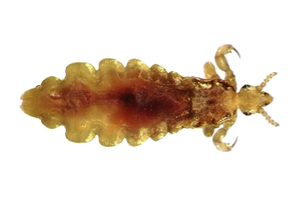What do Lice Look Like?
Size: Between 2 and 4.2 millimeters in length, with small, flat bodies. About the size of a sesame seed.
Color: Varies between whitish to various shades of grey and brown. May look translucent or almost clear.

Lice are tiny parasitic insects that feed on blood to survive. They won’t last long without a human host, but they can last for short amounts of time on clothing and other fabrics. For business owners in the hospitality and clothing retail industries, these tiny bugs can be a big problem. Keeping them under control is vital; nothing tanks a business’s reputation like lice, fleas, or bedbugs.
If you need lice control services, count on Assured Environments. Our team can build a customized plan to help make those bugs a thing of the past.
Lice infest people, not structures–so they’ll leave behind signs of their presence on you and other inhabitants, not the building itself. Lice saliva is also a common allergen. When lice bite you, their saliva will trigger an allergic reaction, resulting in a sudden red rash. This saliva may also irritate the site of the bites themselves, causing swelling, minor pain, and itching. Look for red, swollen, or irritated lice bites on your head, body, and scalp.
Lice also reproduce and lay eggs in human hair. These eggs are called “nits,” and look small, round, and white. Find nits by using a fine-toothed comb to examine your hair very closely. Nits are very small and may be difficult to see. You may also find lice themselves or lice nymphs during a close examination of your hair.
Scientific Order: Phthiraptera
Common Species:
Pediculus humanus capitis, or head louse
Pediculus humanus hmanus, or body louse
Pthirus pubis, or pubic louse
Size: Between 2 and 4.2 millimeters in length, with small, flat bodies. About the size of a sesame seed.
Color: Varies between whitish to various shades of grey and brown. May look translucent or almost clear.

Lice spread by hiding among shared headwear, clothing, and linens (such as blankets or pillowcases). When a new host uses or wears the infested fabric, the lice inside it attach to that host’s hair. The best way to avoid contracting or spreading lice is to be very careful about sharing clothing and headgear such as hats, helmets, or other protective clothing and equipment. Wash all clothing, linens, and equipment frequently, especially if it’s shared.
If you believe you have lice, the first thing you should do is remove them using a nit comb. If the nit comb can’t reliably remove all lice, consider seeing a doctor. You should also take a long and hot shower after using your nit comb to wash away any detached lice. After you’re finished treating yourself, thoroughly examine and wash all clothing and linens in the building. If you rent out clothing or other wearable equipment, you’ll have to check every piece of inventory thoroughly.
All three species of common louse feed on blood exclusively. They begin feeding as soon as they’re born and continue to feed through every developmental stage. Almost all lice will feed on their hosts multiple times in a single day, biting down in multiple different places around the same general vicinity of the body.
Head lice cannot survive more than two days without a blood meal. If they’re removed from a host, they will starve relatively quickly. If lice are in your building or clothing, it’s because they’ve been feeding recently.
Lice reproduce sexually and can reproduce within ten hours of reaching adulthood. Once adulthood has been reached, their main priority becomes reproduction. A single louse has an approximately 30-day life cycle from when its egg is laid until it dies.
A single female head louse can produce 50 to 100 eggs in her lifetime, whereas body lice can lay more than 200 eggs. Lice lay eggs continuously as long they live; most lay 3 to 5 a day. These eggs hatch within 5 to 7 days.
All lice have distinctive hook-like claws at the ends of each of their legs. They use these hooks to cling to hair follicles. Contrary to popular belief, lice can’t fly, jump, or even “bounce” from host to host.
Lice spread only by coming into direct contact with their host’s hair or clothing. They access new hosts either by transferring after direct contact between people or by latching onto a host via an article of clothing.
Lice are temperature and light-sensitive and tend to prefer dark, warm environments.
Lice infestations can be a big problem for many businesses. Luckily, with a few precautions and treatments, your lice problems can be taken care of. With the skills and experience that Assured Environments brings to the table, you’ll have peace of mind like never before.
We offer comprehensive inspections and highly-customized treatment plans so your business gets exactly what it needs, right from the start.
Give us a call to get started with a free inspection!